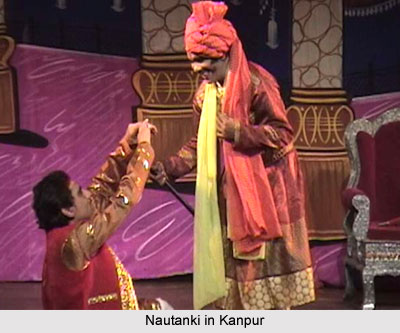 Nautanki in Kanpur (second most populous city in Uttar Pradesh) is quite popular among the entertainment lovers. It is an age old folk theatre from practiced in the Uttar Pradesh state of India. The origin of Nautanki can be found in the folk performance traditions of Bhagat and Raasleela of Mathura and Vrindavan of Uttar Pradesh, and Khayal of Rajasthan. With the spread of Hathras, Swang spread to other regions in the second decade of the twentieth century and the term Nautanki became attached to this performance style. Virtually every poet in his own way retold the popular tale of the princess Nautanki. Evidence of early use of the word to indicate the genre occurs in Shiv Narayan Lai`s Sangit sundarkand rah Nautanki, "The musical play `Sundarkand` in the Nautanki manner." Rah means "road, way; manner, method; custom, fashion," and here designates the performance genre.
Nautanki in Kanpur (second most populous city in Uttar Pradesh) is quite popular among the entertainment lovers. It is an age old folk theatre from practiced in the Uttar Pradesh state of India. The origin of Nautanki can be found in the folk performance traditions of Bhagat and Raasleela of Mathura and Vrindavan of Uttar Pradesh, and Khayal of Rajasthan. With the spread of Hathras, Swang spread to other regions in the second decade of the twentieth century and the term Nautanki became attached to this performance style. Virtually every poet in his own way retold the popular tale of the princess Nautanki. Evidence of early use of the word to indicate the genre occurs in Shiv Narayan Lai`s Sangit sundarkand rah Nautanki, "The musical play `Sundarkand` in the Nautanki manner." Rah means "road, way; manner, method; custom, fashion," and here designates the performance genre.
In the present days Nautanki is becoming extremely popular. But there is fear of the character being corrupted by books on bad subjects. Therefore, writers have adapted the Sundarkand of the revered Ramayana in the style of Nautanki. It has been observed by many legendary artists that among those who write Swangs are particularly ill-educated men who compose vulgar, impure, plots, and completely useless (mahdraddi) Swang and do a great disservice to the country. According to the artists, such people should not trouble themselves in vain with this kind of writing because they do not enhance their personal esteem; on the contrary they increase their ill repute.
Just as the mass appeal of the Swang stage became recognized, some quarters attempted to convert Swang and Nautanki to a more edifying form, one beneficial to the building of moral character. The impact of the new political ideology seemed to intensify just as Nautanki took root in Kanpur. It left a clear mark on the early career of Lord Krishna Khatri Pahalvan, the founder and chief proponent of the Kanpur style.
From the end of the nineteenth century, Hathras troupes had performed regularly in Kanpur, and the Sangits of the Hathras akharas were published there in large numbers. Kanpur`s history was intertwined with the military and economic purposes of the British Raj.
After the opening of railway lines connecting the city to Kolkata and Lucknow in the 1860s, the industrialization of spinning and tanning turned Kanpur into a manufacturing centre surpassed only by Mumbai, Kolkata and Chennai. In 1901, the semi-industrial male labour force was estimated at twenty-seven thousand. Rapid social mobility characterized the society, especially among the lower castes, yet westernization in the sense of interest in British education, culture, nationalist politics, or even religious life scarcely existed. These conditions helped create both the audience and commercial structures that sustained popular entertainments like Nautanki, while minimizing the reformist opposition that might have put a damper on such activities.
Kanpur began to develop its own brand of Nautanki sometime around 1910. One of the first local akharas was that of Ustad Chandi Lal and poet Bhairon Lal, who"s Jagdev Kankali was published in 1914 by Umadatt Vajpeyi of Brahman Press, Kanpur. Explicit political comment and concern with contemporary events are noticeable in several Kanpur plays that retell the tragic massacre at Jallianwala Bagh in Amritsar. One of these, Rashtriya Sangit Julrni Dayar, written by Manohar Lal Shukla in 1922, bears an unusual cover image in allegorical style.



















